THE PYRAMIDS OF EGYPT
Among
the great wonders of the ancient and the modern world,
the Pyramids of Giza are the most imposing surrounded by
other group of pyramids standing on the edge of the
desert in the vicinity of Cairo. The largest of them all
is the Pyramid of Kheops, which was built nearly five
thousand years ago. The sides of the pyramid, each 746
feet long, face the points of the compass; its height is
450 feet and the area covered is nearly 13 acres of
land. Some idea of the enormous amount of labor involved
is the Pyramid consists of 230,000 blocks of stone, each
weighing two and a half tons. The second pyramid is that
of Khephren, is only slightly smaller, but the third of
Mykerinos is about half the size of the Pyramid of
Kheops. Nearby, is the Cemetery of Kings, with the tombs
of the members of the royal household and high officials
of the court. And, far away in the distance are seen
other smaller pyramids.
FORTRESS OF SALAHUDDIN
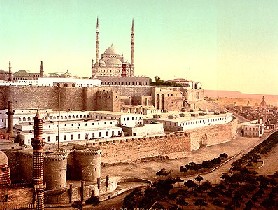 The Citadel
that commands Cairo was originally built by the great
Salahuddin (famous for his battles against the
Crusaders) from stones near the Pyramids of Giza. It was
also called as a Mountain Citadel. It was completed
during his lifetime but he never moved into it. He
ordered a well to be dug inside the fortress to bring up
potable water. It was intended to be a secure source of
water in case of siege. The well of Yusuf as it was
called was considered as a great achievement. It was dug
in solid rock to a depth of 86 meters, formed of two
parts: the upper and lower part. The upper part of the
well is surrounded by a flight of steps cut into the
rock leading down to a middle platform. A water wheel
was placed on this platform was turned by animals to
lift water from the lower parts of the well. Sweet water
flowed at first from the well, but with further digging,
salt water from the sea seeped through and the Sultan,
therefore, continued to live in the wazirite quarters.
His nephew and successor Al-Kamil moved to the Citadel,
but after building a canal on the top of the eastern
wall of the Citadel to carry water into it from the
River Nile. The picturesque walls and minarets of the
Cairo fortress still continue to decorate the landscape
of Egypt.
The Citadel
that commands Cairo was originally built by the great
Salahuddin (famous for his battles against the
Crusaders) from stones near the Pyramids of Giza. It was
also called as a Mountain Citadel. It was completed
during his lifetime but he never moved into it. He
ordered a well to be dug inside the fortress to bring up
potable water. It was intended to be a secure source of
water in case of siege. The well of Yusuf as it was
called was considered as a great achievement. It was dug
in solid rock to a depth of 86 meters, formed of two
parts: the upper and lower part. The upper part of the
well is surrounded by a flight of steps cut into the
rock leading down to a middle platform. A water wheel
was placed on this platform was turned by animals to
lift water from the lower parts of the well. Sweet water
flowed at first from the well, but with further digging,
salt water from the sea seeped through and the Sultan,
therefore, continued to live in the wazirite quarters.
His nephew and successor Al-Kamil moved to the Citadel,
but after building a canal on the top of the eastern
wall of the Citadel to carry water into it from the
River Nile. The picturesque walls and minarets of the
Cairo fortress still continue to decorate the landscape
of Egypt.
AL AZHAR- THE LEADING UNIVERSITY OF THE MUSLIM WORLD
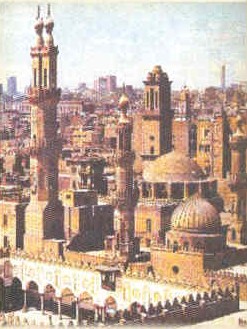 The Mosque
of Al-Azhar in Cairo was completed in 971 CE, but
frequently rebuilt and enlarged by its benefactors, the
rulers of Egypt, and has been from its inception one of
the principal universities of the Islamic world. Muslims
all over the world traveled to it on their way to Makkah
and to seek knowledge. Frequented by students,
professors, and foreigners from different parts of the
world, it became famous as a place for teaching the Holy
Qur’an and other sciences. Instruction is free and the
complete course of studies lasts fifteen years. The
library of Al-Azhar has one of the best collections of
rare books and valuable manuscripts. Al-Azhar is one of
the main authorities in Sunni Islam today, and the
university that grew out of it is the oldest Islamic
university in the world.
The Mosque
of Al-Azhar in Cairo was completed in 971 CE, but
frequently rebuilt and enlarged by its benefactors, the
rulers of Egypt, and has been from its inception one of
the principal universities of the Islamic world. Muslims
all over the world traveled to it on their way to Makkah
and to seek knowledge. Frequented by students,
professors, and foreigners from different parts of the
world, it became famous as a place for teaching the Holy
Qur’an and other sciences. Instruction is free and the
complete course of studies lasts fifteen years. The
library of Al-Azhar has one of the best collections of
rare books and valuable manuscripts. Al-Azhar is one of
the main authorities in Sunni Islam today, and the
university that grew out of it is the oldest Islamic
university in the world.
THE SUEZ CANAL-ARTERY OF THE ASIATIC TRADE
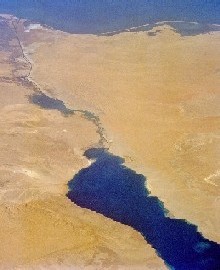 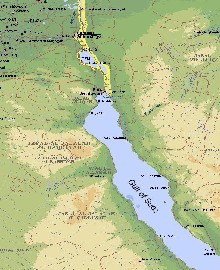
The
Suez Canal was constructed by the genius of Ferdinand de
Lesseps at a cost of nineteen million British Pounds. It
links the Mediterranean Sea directly with the Red Sea,
shortening the sea route to India by 5,500 miles. The
Canal is about 104 miles long with minimum bottom width
of150 feet and has a depth of 33 feet. It formed an
important link of the maritime communications of the
British Empire during the Second World War.
Today, Suez is one of Egypt's largest ports.
SAHARAN OASES-A WONDER OF THE DESERT
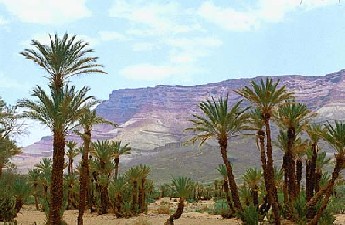
Not
all of Sahara is arid waste. On its fringes and
scattered in the interior of the desert are great
numbers of oases. The center of the oasis is a water
pool resulting from springs coming to the surface. These
pools make their immediate neighborhood most fertile and
support a vast number of date palms and other
vegetation. People living in the desert inhabit most of
the oases.
MEASURING THE WATER OF NILE-THE NILOMETER
On
the island of Rawdah in the Nile, near Cairo is the
famous Nilometer erected by Caliph Sulaiman in the year
716 CE to measure the level of the river, and when a
certain height was reached the signal used to be given
for a general release of life-giving water into the
irrigation channels. The rate of taxation in Egypt was
calculated on the height of water recorded in the
Nilometer.
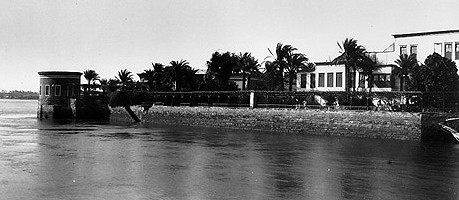
At first, the measuring devices were installed in open
air, but as the surface of water remained unstable with
the changing winds a device had to be thought of to keep
the water surface stable enough to give accurate
readings. The Arabs designed a device in the form of a
deep well surrounded by walls and connected with the
Nile at the same time. The result was what is known as
the Nilometer in the Rawdah Island. The selection of
mortar used in the building of the walls shows that the
Arabs had a good knowledge of building materials, since
it has resisted erosion from water for more than a
thousand years!
MARKETS OF ERFOUD
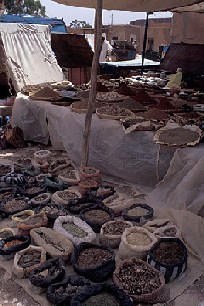
Erfoud,
a walled town, one of the several in the oasis of
Tafilalet, lies deep in the heart of Saharan Desert of
Morocco. Despite its isolation, it has been serving as
an important market place through the centuries as a
market place and acts as a meeting-point of traders from
all over the Sahara Desert. It has a remarkable market
place, an enormous area with elaborate arcades. For a
thousand years, this was a principal trading post for
caravans traveling across the Sahara Desert, where gold
was exchanged for salt and sugar. Even to this day, it
is the meeting place for desert tribes who come there to
swap silver jewelry and rugs for vegetables, salt and
other goods.
ROCK PINNACLES CARVED BY WIND
These
extraordinary pillars of rock are to be seen in
Tassili-des-Ajjer, in the Eastern Sahara about fifty
miles north of Djanet. The soft sandstone of a rocky
ridge has been worn into fantastic shapes in the course
of centuries by the constant friction of countless
particles of windblown sand. (Figure 1)
CRAG-BUILT CITY SACRED TO THE MOROCCANS
Mulai
Idris who died in 791 CE was the Sultan who first
introduced Islam into Morocco, and is considered by the
Muslims of Morocco as a holy man. The whole town of
Mulai Idris, Zarhoun, the scene of his death is regarded
as a sacred sanctuary. Its chief claim to distinction,
however, is its remarkable site. The whole town of
Zarhoun has been built completely over a huge steep rock
crag that rises from the floor of the valley. (Figure
2)
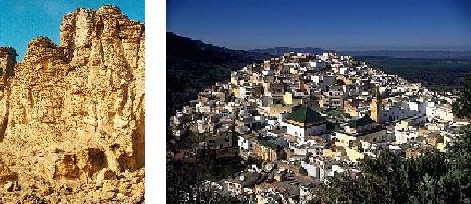
Figure 1
Figure 2
| 